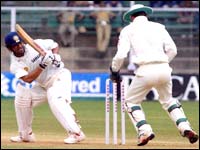Of mere mortals and paranoia
Jaydeep Sarkar
There has been a spate of recent articles written by leading journalistic lights, particularly from India, on whether the Indians were right to appeal against Michael Vaughan in the recently-concluded Test, and whether the English ploy of bowling outside the leg-stump was correct in terms of the 'spirit' of the game.
Both these issues pertain to two separate realms of cricket practice: one aspect relates to complying with the rules and regulations that govern the game, whilst the other pertains to playing the game in the right 'spirit', whatever that term might imply. I would put to you that there is a substantial subjective element in the term 'spirit', such that it might mean different things to different people. What the term sporting spirit means to a person, depends largely on that person's own general sets of values and attitudes about a game ought to be played.
 Any game and its players should seek to uphold not only the letter of the law by which the game and the practices of its players is governed, but also the spirit behind the law.
Any game and its players should seek to uphold not only the letter of the law by which the game and the practices of its players is governed, but also the spirit behind the law.
The Indians were right to appeal against Vaughan under the article of the law, which states that a person may not handle the ball in order to help a fielder (such as the action of Vaughan, as claimed by him), if it occurs without the consent of a member/s of the fielding side. Therefore, in the laws of the game, the Indians were justified in appealing as Vaughan had not sought prior permission of a fielder. The umpire had no alternative but to give him out "handled the ball".
However, one has to question the spirit under which the appeal was made. Surely, Vaughan would not have seen his stumps disturbed by the ball ricocheting into it, nor was he attempting to prevent Dasgupta from catching the ball as it had not come off his bat, nor indeed was he at risk of being run-out. However, for reasons mentioned above, 'spirit' reflects a person's own sets of sporting principles and is not laid down as a given.
The English players, by the same token, were justified in bowling outside the leg stump. It was not negative bowling, because preventing a batsman from scoring is as much part of Test cricket as taking wickets are. Otherwise most teams might end up scoring 900-plus in an innings. Furthermore, the South Africans consistently bowl a foot outside the off-stump in order to prevent free-stroking batsmen from scoring at a fast pace.
Jacques Kallis is a great proponent of such bowling tactics and the recently-concluded series often saw him bowl consistently outside the off-stump. In the past, Shane Warne has regularly bowled outside the leg stump, as a ploy, both to prevent batsmen from scoring as well as in an attempt to bowl them behind their legs. History suggests that he has been quite successful against various teams with such attempts.
During the era of the great West Indian fast bowlers of the eighties, one consistently watched several of them bowling short pitched balls in attempts to stifle the scoring rate, intimidate the batsmen and eventually take their wickets. Never was there a suggestion that they had indulged in negative practice. None of the objections that have been raised now about the English tactics, by Indians predominantly, have been held to be valid in the past. Why should it be so now?
Furthermore, the umpires saw nothing wrong with what Flintoff and Giles were doing, significantly so,
as they are now empowered by new laws that did not exist a few years ago, wherein they can call a 'wide ball' if they are convinced that the fielding team is indulging in blatant negative tactics. One has to conclude that there was nothing illegal about Englishmen bowling outside the leg stump.
A broader question is whether such bowling was against the spirit of the game? Possibly so, because it denied Indian spectators from enjoying Tendulkar's batting. After all, cricket as a game would not survive without spectator interest.
The effort of Giles and co., if it continues against other Test sides, especially in England, where cricket struggles to compete for the attention of the common man, can and must sound the death knell for this game as such tactics might make the game boring to watch. However,
no game, least of all cricket, exists for the viewing pleasure of spectators only, although continued patronage is significant for any game's sustenance, including cricket. Teams have to win for spectators in their own countries to follow the game.
At the very least, they should avoid losing. The English team, with four of its leading players missing from the Test squad, with an inexperienced bowling attack and having performed below
expectations during the English summer against Pakistan and particularly Australia,
wished to avoid defeat at any cost. Especially after losing the first Test.
Losing a series 1-0 is any day better than losing it 3-0. Thus, in terms of
English 'spirit', England was justified in bowling the line they chose to. But
were they guilty of ignoring the general sporting ethics by which games are played? In other words, were they justified in bowling outside Tendulkar's leg stump, even if it meant that they ensured that a loss would be driven out of any equation?
Following closer viewing of such a bowling tactic, one has to question whether England were even guilty of playing against the spirit of the game.
 Sehwag demonstrated that when a batsman is prepared to take the fight to
the bowler, it is not very difficult to score off him, thus raising the
important question whether Tendulkar was over cautious against Giles? That this was the case is exemplified by the fact that when Tendulkar, in an attempt to emulate Sehwag, who had began blasting the miserly bowler, chose to attack Giles, he was able to accumulate 12 runs in a single over.
Sehwag demonstrated that when a batsman is prepared to take the fight to
the bowler, it is not very difficult to score off him, thus raising the
important question whether Tendulkar was over cautious against Giles? That this was the case is exemplified by the fact that when Tendulkar, in an attempt to emulate Sehwag, who had began blasting the miserly bowler, chose to attack Giles, he was able to accumulate 12 runs in a single over.
It was perhaps the exploits of Sehwag at the other end that prompted the little master to come out of a self-imposed shell. In fact, he perished in an attempt to perpetuate this particular mode of playing Giles. Is it justifiable to blame England for Tendulkar's self-imposed discipline to balls outside the leg stump?
It is not, and any attempt to do so should lead to more serious questions
about the 'spirit' in which Indian spectators watch the game, and more
importantly, the 'spirit' in which the self-styled shapers of the Indian mind set, the cricket journalists, play the 'game'.
If Hussain states that he will leave the issue of Indians' appealing
against Vaughan to the judgement of the readers, then he has a right to do so and
no one should demand that he should not make such comments, as a senior journalist writing in these columns has asserted. If Indians choose to crib about leg side bowling, then they have a right to do so, but only as a justification for Tendulkar's inability or more specifically, his unwillingness to attack this line of attack, and nothing else.
Regrettably, we Indians are becoming increasingly intolerant of other teams and their tactics, perceiving slights and insults, when perhaps none has been implied. We are looking for ghosts and spirits on the grounds of play and outside of it to explain away the lack of positive results by the team, rather than identifying the glaring deficits and a singular lack of resolve and application by the men in whites (and often blue), that we have come to identify as demigods.
By indulging in a behaviour wherein attribution for poor result is externalized, we run the risk of becoming the biggest whingers playing the game. That our national self-esteem and pride are determined and held hostage by mere 11 men on a cricket field raises more serious issues about the nation in general. By becoming paranoid about the intents and purposes of others, we might succeed in the short-term by keeping our peace with our own selves, and deflecting from the more insidious and hurtful truth: that India as a cricket team is no more skilled and talented than
many others that play the game today.
The day we are able to accept this truth, we will begin to see our players as mortal men of flesh and blood, rather than all-conquering powerslaves. We might even begin to enjoy the game for what it is and start to rectify some of more contentious issues that exist within the team and some of its followers. Until such a day dawns, I put to you, the hidden hand stories, the racism element, the conspiracy theories will rule along with those who spin such webs on a population that is
often disappointed by its 'demigods.
Editor's note: Rediff believes that like its own editorial staffers, readers too have points of view on the many issues relating to cricket as it is played.
Therefore, Rediff provides in its editorial section space for readers to write in, with their views. The views expressed by the readers are carried as written, in order to preserve the original voice.
However, it needs mentioning that guest columns are opinion pieces, and reflect only the feelings of the individual concerned -- the fact that they are published on Rediff's cricket site does not amount to an endorsement by the editorial staff of the opinions expressed in these columns.
Mail Jaydeep Sarkar